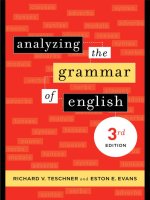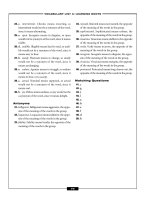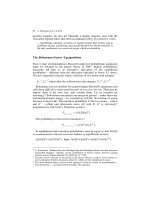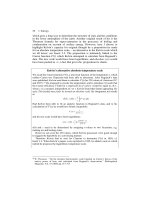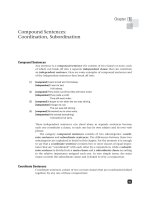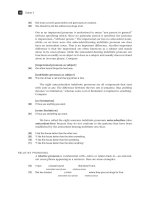Analyzing the Grammar of English Third Edition phần 4 doc
Bạn đang xem bản rút gọn của tài liệu. Xem và tải ngay bản đầy đủ của tài liệu tại đây (268.53 KB, 27 trang )
59
+ Someone called him.
− Someone didn’t call him.
yn+ Did someone call him?
yn− Didn’t someone call him?
wh/co Who called him?
Here, who merely substitutes for the indefinite pronoun someone, which already
serves as the subject throughout the four other structures. So since someone
already appears at the front, no fronting rule can apply.
Activity 3.1
THINKING IT THROUGH
A. Fill in the blanks with the absent structures. Be sure to retain the same tense throughout
each set. There are usually several ways to fill in the wh/co blank since—as we already
know—there are eight wh-words and therefore almost as many wh/co questions that they
can function in.
1. + We know them.
− .
yn+ ?
yn− ?
wh/co ?
2. + .
− .
yn+ ?
yn− Don’t they pay their bills?
wh/co ?
3. + .
− I don’t understand that.
yn+ ?
yn− ?
wh/co ?
Wh-Words as Subjects vs. Wh-Words as Objects
055-078.Teschner.03.indd 59055-078.Teschner.03.indd 59 4/2/07 6:09:29 PM4/2/07 6:09:29 PM
Chapter 3
60
4. + .
− .
yn+ Did I speak to you?
yn− ?
wh/co ?
5. + .
− .
yn+ ?
yn− ?
wh/co When do you arrive?
6. + .
− She isn’t practicing enough.
yn+ ?
yn− ?
wh/co ?
7. + He has been sick.
− .
yn+ ?
y− ?
wh/co ?
8. + .
− .
yn+ ?
yn− Wouldn’t he know when to go?
wh/co ?
055-078.Teschner.03.indd 60055-078.Teschner.03.indd 60 4/2/07 6:09:30 PM4/2/07 6:09:30 PM
61
9. + .
− I won’t tell you his name.
yn+ ?
yn− ?
wh/co ?
10. + .
− .
yn+ ?
yn− ?
wh/co Whom had he been talking to?
11. + .
− .
yn+ Has it turned out nicely?
yn− ?
wh/co ?
WRITING IT OUT
B. Complete each of the following phrases in a sentence you make up.
1. What did he
2. They didn’t
3. Why do you
4. Have they been
5. When weren’t we
6. I am trying
Wh-Words as Subjects vs. Wh-Words as Objects
055-078.Teschner.03.indd 61055-078.Teschner.03.indd 61 4/2/07 6:09:30 PM4/2/07 6:09:30 PM
Chapter 3
62
7. Did she ever
8. I just don’t
9. Couldn’t she
10. Had the butler
11. Won’t you
12. What could he have
13. Does the watch dog
14. Didn’t the thief
C. Provide one example of each of these products or processes.
1. do-insertion
2. the wh-fronting rule
3. auxiliary inversion
4. be as a nonmodal auxiliary
5. do as an LV
6. a wh-word as object
7. a wh-word as subject
8. a wh/co question
055-078.Teschner.03.indd 62055-078.Teschner.03.indd 62 4/2/07 6:09:31 PM4/2/07 6:09:31 PM
63
D. Write statements or questions that correspond to the following descriptions.
1. yn+ ; know as LV
2. wh/co; stay as LV; wh-word as subject
3. − ; own as LV
4. + ; write as LV
5. yn− ; kill as LV
6. wh/co; leave as LV; wh-word as object
7. wh/co; drop as LV; wh-word as subject
8. yn+ ; tell as LV
Selection Questions
A selection question combines two or more yn+ questions into a single inter-
rogative entity. The coordinating conjunction or typically serves as the tie-in
element. Thus:
[11] yn+ : Do you want to fly to New York?
[12] yn+ : Do you want to drive to Miami?
[13] combined: Do you want to fly to New York or drive to Miami?
Question (13), which combines questions (11) and (12), can no longer be
answered yes or no the way its two component parts could. Instead, one must
select one of the choices offered. Here are several possible answers:
[14] I want to fly to New York.
[15] Fly.
[16] New York.
[17] The former.
[18] Whatever. (etc.)
Declarative Questions
A declarative question is a yes/no question (either + or −) that lacks auxiliary
inversion, lacks do-insertion, etc.; therefore, declarative questions manifest the
Declarative Questions
055-078.Teschner.03.indd 63055-078.Teschner.03.indd 63 4/2/07 6:09:31 PM4/2/07 6:09:31 PM
Chapter 3
64
same word order as declarative structures (the + sentence). Compare the follow-
ing examples:
[19] +: You want a sandwich.
[20] yn+: Do you want a sandwich? [do-insertion and aux inversion]
[21] declarative question: You want a sandwich? [said with rising intonation]
A declarative question’s function somewhat resembles that of an echo question’s
function (see just below) in that declaratives express shock or surprise or ask for
simple verification. In colloquial and informal English, declarative questions are
frequent, as are yn+ and yn− questions that lack the auxiliary verb:
[22] Do you want to go now? → You want to go now? → Wanna go now?
[23] Don’t you have any money? → You have any money? → Got any money?
[24] Are you ready to leave? → You ready to leave? → Ready to leave?
[25] Is he studying already? → He studying already?
Echo Questions
Echo questions are “recapitulatory” in that they repeat, directly or in paraphrase,
all or part of what someone else has just said, either to confirm it or to express
surprise or disbelief. An echo question typically employs rising intonation.
Examples:
[26] Yesterday I bought a BMW.—You bought a BMW?
[27] I want some slivovitz.—You want some what?
[28] The two-bedroom bungalow in Beverly Hills costs $3,000,000.—It costs how much?
Echo questions can also function as questions about questions in which the lis-
tener speculates on or makes fun of a question someone else just asked. Often
these questions about questions are so obvious as to be amusing:
[29] Is Bill Gates a billionaire?—Is Bill Gates a billionaire? Is the pope Catholic?
The main functional difference between declarative questions and echo ques-
tions is that echoes must literally echo something that someone else has just fin-
ished saying; declaratives, on the other hand, can begin a conversation between
two people and do not have to respond to something already stated or asked.
Tag Questions
A tag question always appears (following a comma when written) as the sole
interrogative element in an otherwise noninterrogative sentence. A tag ques-
tion’s purpose is to get the listener to confirm or deny what the speaker has
just stated in the (noninterrogative) “assumption” part of the sentence. There
are four types of combinations involving assumptions and tag questions. Two
combinations contain—in the assumption—positive statement verbs and thus
have positive assumptions, but the other two combinations contain—again in
055-078.Teschner.03.indd 64055-078.Teschner.03.indd 64 4/2/07 6:09:32 PM4/2/07 6:09:32 PM
65
the assumption—negative statement verbs and thus have negative assump-
tions. If the tag itself is spoken with a rising intonation, the speaker is actu-
ally in doubt as to how the tag will be answered. But if the tag is spoken with a
falling intonation, the speaker fully expects that the tag will elicit a confirma-
tive response in which the respondent will agree with the speaker’s assumption.
In the tree (fig. 3c) and in the two subsequent tables (figs. 3d and 3e), we will
outline the four types of tag questions in schematic form, then exemplify and
explicate each.
Invariant Tags
An invariant tag is one whose verb form—negative or affirmative—is not depen-
dent on the positivity that its antecedent noninterrogative statement manifests.
Mostly, however, invariant tags—especially the most colloquial ones—do with-
out verb forms altogether. Examples:
[30] You’re going to get angry again, right?
[31] This time they’ve really gone off the deep end, huh?
[32] So she’s getting ready to go now, eh?
Elliptical Responses
An elliptical response is a response to a yes/no question in which only part of
that question is repeated in the response. Here are some examples (which give
the omitted [ellipticized] words in brackets):
[33] Was he sick yesterday?—Yes, he was [sick yesterday].
[34] Had he been seeing a doctor regularly?—Yes, he had [been seeing a doctor regularly].
The typical elliptical response repeats only the first verb form of the question,
changing the verb’s form if necessary but not its tense.
Elliptical Responses
Figure 3c Tag Questions: The Tree
expectation: in-doubt
tag question
positive
confirmativein-doubt confirmative
negativeassumption:
a. Positive assumption, in-doubt expectation
b. Positive assumption, confirmative expectation
c. Negative assumption, in-doubt expectation
d. Negative assumption, confirmative expectation
Figure 3d Tag Questions: The Outline
055-078.Teschner.03.indd 65055-078.Teschner.03.indd 65 4/2/07 6:09:33 PM4/2/07 6:09:33 PM
Chapter 3
66
Activity 3.2
THINKING IT THROUGH
A. Identify each of the underlined elements as (i) selection questions, (ii) declarative ques-
tions, (iii) echo questions, (iv) tag questions (in which case be sure to comment on the intona-
tional possibilities), (v) invariant tags, or (vi) regular yn+, yn– or wh/co questions.
Example of how to proceed:
X. He gained fifty pounds last year, didn’t he? The underlined words constitute a tag ques-
tion, whose intonation could be either rising or falling.
a. positive assumption, in-doubt expectation
He likes his boss, doesn’t he? [rising intonation]
(Here the speaker is in doubt so the tag assumes nothing; the subject may or may
not like his boss; we simply want to know.)
b. positive assumption, confirmative expectation
He likes his boss, doesn’t he? [falling intonation]
(Here the speaker assumes that the subject likes his boss; thus the speaker’s tag is
merely seeking to get the listener to confirm the speaker’s assumption.)
c. negative assumption, in-doubt expectation
He doesn’t like his boss, does he? [rising intonation]
(The speaker is in doubt so the tag assumes nothing; the speaker may or may not
like his boss; we simply want to know.)
d. negative assumption, confirmative expectation
He doesn’t like his boss, does he? [falling intonation]
(The speaker assumes the subject does not like his boss; thus the speaker’s tag
merely seeks to get the listener to confirm the speaker’s assumption.)
Here is a very important fact: As far as the tag’s mechanics are concerned,
a negative assumption always generates a positive tag, and vice versa:
He likes . . . , doesn’t he? + , −
He doesn’t like . . . , does he? − , +
e. There is, however, a fifth though less frequent type of assumption/tag
combination that involves a rising intonation tag that typically expresses
sarcasm, in which both the assumption and the tag are positive:
Oh so you’ve done your homework, have you? [We assume that he hasn’t!]
Figure 3e Tag Questions: The Examples and the Explanations
055-078.Teschner.03.indd 66055-078.Teschner.03.indd 66 4/2/07 6:09:33 PM4/2/07 6:09:33 PM
67
Elliptical Responses
1. Would I lie to you?
2. She sells sea shells, doesn’t she?
3. Our muddahs was right, huh, Charlie? Ya gotta stick witcher own kind.
4. The hamster ate the cobra?
5. Just give me a break, man.—You, a break?
6. When exactly did the perpetrator perpetrate the crime, ma’am?
7. Doesn’t it feel good to be drawn and quartered?
8. Sure and ’tis a great day for the Irish, isn’t it?
9. Do you want peanut butter and jelly?
10. Do you want peanut butter or jelly?
11. You’re going to give a million dollars to charity?
12. When ya gotta go, ya gotta go, right?
13. Why’s he always making the same mistake?
14. Why he’s always making the same mistake?
15. They’re sick?
16. They don’t know what they’re doing, do they?
055-078.Teschner.03.indd 67055-078.Teschner.03.indd 67 4/2/07 6:09:34 PM4/2/07 6:09:34 PM
Chapter 3
68
B. Give all possible tag questions for the following statements. Mark rising or falling intona-
tion with arrows, then tell which of the five tag types your question belongs to—(a), (b), (c),
(d), or (e) (sarcasm).
1. We all know what his story is, ?
2. Only some of my friends came to the wedding, ?
3. You just don’t understand the issue, ?
4. Now is the time for all good women to come to the aid of their party, ?
5. So you’ve wrecked the car again, ?
6. I get totally wasted at parties, ?
7. She feels nothing but utter contempt for the faculty, ?
C. Give elliptical responses to the following questions.
Example of how to proceed:
X. Was the summer wind blowing strong? Yes, it was.
1. Have you been a good little girl? .
2. Will they have been working for forty-eight hours straight by
then? .
3. But do you really think he’s worth $3 an hour? .
4. Won’t he tell me where to get off? .
5. Was she able to answer the question? .
Emphasis and Emphatic Structures
English achieves emphasis in a variety of ways. One way is by applying peak
stress—the most salient degree of vocal emphasis—to the word you want to
emphasize. Peak stress can involve any one of these three things, separately or in
combination: (a) increased loudness, (b) higher or lower pitch, or (c) length-
ening the syllable. Almost any word can be peak stressed to achieve emphasis.
The purpose of emphasis is to shift or draw attention to the focus of the utter-
ance. For example, in a sentence such as (35)—
[35] Josie told me that you were sick.
—peak stress on Josie conveys the information that it was Josie (and not someone
else) who told me; peak stress on told says the information was conveyed verbally
055-078.Teschner.03.indd 68055-078.Teschner.03.indd 68 4/2/07 6:09:35 PM4/2/07 6:09:35 PM
69
Emphasis and Emphatic Structures
and not in writing (or that Josie really did tell me, despite what people say); peak
stress on me emphasizes the fact that Josie told me and not someone else, etc.
Another way English achieves emphasis is through do-insertion, which as we
already know involves adding the appropriate tense/number form of the non-
modal auxiliary verb do to the emphatic structure and then stressing that form,
thereby emphasizing the action of the verb. Here is an example:
Unemphatic [a plain statement of fact]:
[36] Janice studies calculus every night.
Emphatic [possibly intended to contradict someone’s assertion to the
contrary]:
[37] Janice does study calculus every night.
In sentence (37), does—the product of do-insertion—can be viewed as a dummy
verb because it does not have to be there for syntactic reasons. (Sentence [37]
is neither a question nor a negative.) Nor is does an LV, since it lacks an LV syn-
onym. Compare (37)’s does with (38)’s:
[38] Janice also does the dishes faithfully.
In (38), does is synonymous with washes, so since this LV synonym has been
found, (38)’s does is not a dummy verb.
There is yet another way that English can emphasize the action of the verb:
by avoiding a contraction and then peak stressing one of the two noncontracted
elements—the verb form itself or the negative not. Examples:
Unemphatic [with contraction]:
[39] Muriel can’t practice her cello tonight.
Emphatic [without contraction; the emphasized element appears in
boldface type with an acute accent mark on top of it]:
[40] Muriel cánnot practice her cello tonight.
[41] Muriel can nót practice her cello tonight.
Activity 3.3
A. Make emphatic items unemphatic and vice versa. Then read both the emphatic and the
unemphatic versions out loud, rendering them properly by putting the peak stress where it
belongs.
Example of how to proceed:
X. Amazon natives know many medicinal secrets.
“This sentence is unemphatic as written. Any one of its six words can be made
emphatic, thus: ‘Amazon natives [as opposed to the natives of other regions] know
many medicinal secrets,’ ‘Amazon natives [as opposed to people who live in the Amazon
but are not from there] know many medicinal secrets,’ and so forth. And here is how I
would read each version out loud: [First reading peak stresses Amazon, second reading
natives, and so forth.]”
055-078.Teschner.03.indd 69055-078.Teschner.03.indd 69 4/2/07 6:09:35 PM4/2/07 6:09:35 PM
Chapter 3
70
1. We can not stand Pat.
2. They don’t like to see him die.
3. We will fight them on the beaches.
4. She’s sick and tired of all that.
5. Why are we in Samoa?
6. Someone’s knocking at my door.
7. They’ve done everything possible to hurt us.
8. She’d tried to make him behave.
9. She’d try to make him behave if you only let her.
10. I won’t put up with you anymore.
11. Do you have any bread?
12. Janice always does what she is told.
055-078.Teschner.03.indd 70055-078.Teschner.03.indd 70 4/2/07 6:09:36 PM4/2/07 6:09:36 PM
71
B. Read sentence (1) out loud five times and sentence (2) out loud four times, stressing, in
turn, every word in the sentence. Then explain the difference between each of the several
versions of what you have read aloud.
1. I know why you failed.
2. Italians love grandiose operas.
Contractions: A Summing Up
As is well known (and as the many examples from the previous sections have
made clear), English really loves to contract. Yet even in English there are lim-
its to contraction. Most contractions involve not or the auxiliaries—modal and
nonmodal alike. We will start our discussion with not and how it both can and
cannot form contractions.
CONTRACTING NOT
Not contracts by dropping the vowel; the result is n’t in writing, which is pro-
nounced [nt] or [cn t], depending on whether n’t forms a separate syllable. (In
rapid speech, the [t] is often dropped, leaving [n] or [cn ] as the remnant.) When
not contracts (and contraction is optional, though frequent in colloquial speech),
the contraction follows and, in writing, is attached to:
a. all finite forms of the nonmodal auxiliaries do/be/have. (Finite means all con-
jugated forms; excluded of course are the present/past participles and the
infinitive, which are timeless forms.) Examples follow of do/be/have + n’t:
DO: doesn’t, don’t, didn’t
BE: aren’t, isn’t, wasn’t, weren’t, amn’t [British Isles only]
HAVE: hasn’t, haven’t, hadn’t
b. all modal auxiliaries (though in some cases the contraction is rare and
unusual): can’t, couldn’t, mayn’t [very rare], mightn’t, mustn’t, shan’t [mainly
British], shouldn’t, won’t, wouldn’t, oughtn’t, usedn’t to [very rare]
NONMODAL AUXILIARIES’ CONTRACTIONS
Many of the nonmodal auxiliaries also form contractions in a variety of verb
tenses. They do so by attaching their contracted forms to the end of nouns and
pronouns whether personal, possessive, or indefinite. Contracted auxiliaries also
attach themselves to the end of wh-words and to here/there.
Of course not all auxiliaries enter into all possible contractions, as certain
constraints do exist. Note also that auxiliaries do not form contractions before
pauses (such as at the end of a sentence); thus He’s ready when I’m ready is gram-
matical but *He’s ready when I’m is not. (By contrast, not often appears in pre-
pausal position: I can but he can’t.)
Contractions: A Summing Up
055-078.Teschner.03.indd 71055-078.Teschner.03.indd 71 4/2/07 6:09:36 PM4/2/07 6:09:36 PM
Chapter 3
72
BE: contracts widely in its present-tense forms
Present tense, present progressive
I’m
you’re (You’re running scared today; cf. the possessive determiner your: Your run-
ning scared them)
he’s
she’s
it’s (It’s very hot today; cf. its as a possessive determiner: The cat lost its bell)
we’re (We’re going to leave; cf. were as a past tense form of be: We were going to
leave)
they’re (They’re leaving on the next plane; cf. their, a possessive determiner: Their
leaving on the next plane worries me)
no one’s (He says that no one’s home right now; cf. the genitive construction no
one’s, as in No one’s home should be set on fire)
somebody’s (Somebody’s very angry at you; cf. the genitive construction some-
body’s, as in Somebody’s car got stolen)
here’re (Here’re the people I told you about)
when’s (When’s the plane leaving?)
etc.
Past tense, past progressive
In standard written English, BE never contracts its past tense forms was and were
because the contractions they would form—’s and ’re, respectively—have already
been “claimed” by BE’s present-tense forms is and are, so the result would be
confusion. But in several somewhat stigmatized lects of spoken English, these
forms—especially was—indeed contract, as our examples show: Where’s you
headin’ off to yesterday when I seed you down the store?—I’s fixin’ to rustle me up
a mess a greens. In these examples the written form (’s) disguises the contrac-
tion’s pronunciation, typically /əz/. Cf. the standard Where’s [Where is] the key
to the front door? in which Where’s is a single stressed syllable and thus without a
schwa: /hwεrz/.
DO: very limited contraction range
Present tense
Do offers no contractions of its present tense forms except does
, which contracts
with what/when/where/why/how in colloquial speech: What’s he do for a living?
When’s he usually get home? Where’s he work?
Past tense
Past tense did contracts only with what/when/where/why/how in colloquial speech,
for example, How’d he learn her name? Where’d he go to school? Why’d he tell you
that?
HAVE: As an aux it contracts almost everywhere with almost everything. A have
contraction can be attached to subject nouns as well as to personal, pos-
sessive, and indefinite pronouns. Here is the full range of contractional
possibilities involving those, with comments when needed. (For remarks
on aux have’s contractions to all eight wh-words see below.)
055-078.Teschner.03.indd 72055-078.Teschner.03.indd 72 4/2/07 6:09:37 PM4/2/07 6:09:37 PM
73
Have as a contracted aux in all four perfect tenses:
future perfect tense:
I will have talked
I’ll have talked
I will’ve talked
?I’ll’ve talked (As a tense, the future perfect appears to form part of too high a
register for this double contraction to appear.)
conditional perfect tense:
I would have talked
I’d have talked
I would’ve talked
I’d’ve talked/I’d’a talked (At first glance, the conditional perfect appears to be
every bit as much of a high registered tense as the future perfect, yet mul-
tiple contractions—including the second of these in which have is reduced
to a schwa—are highly frequent in colloquial speech, especially in north-
ern/northeastern lects of American English and in both the if-clause and
the result clause [see chapter 2], thus: [If] I’d’a seen him in time I’d’a warned
him off [cf. the more standard If I had seen him in time I would have warned
him off; note that I’d’a seen him is a contraction of the pleonastic If I would
have seen him, itself a stigmatized usage].)
present perfect tense:
I have talked
I’ve talked
past perfect tense:
I had talked
I’d talked
Have as a contracted aux in all four perfect progressive tenses:
future perfect progressive:
I will have been talking
I’ll have been talking
I will’ve been talking
I’ll’ve been talking
conditional perfect progressive
I would have been talking
I’d have been talking
I would’ve been talking
I’d’ve been talking
?I’d’a been talking (This usage is questionable, perhaps because the conditional
perfect progressive is too high registered a tense to give rise to a double
contraction such as this.)
present perfect progressive
I have been talking
I’ve been talking
Contractions: A Summing Up
055-078.Teschner.03.indd 73055-078.Teschner.03.indd 73 4/2/07 6:09:38 PM4/2/07 6:09:38 PM
Chapter 3
74
past perfect progressive
I had been talking
I’d been talking
Contracted have can be attached to all wh-words (what/when/where/which/who/
whose/why/how) as well as to the nonreferential there (see chapter 7), especially in
colloquial speech. Here are some examples:
[42] What’s Ordell ever done for us?
[43] Why’s he told you so many lies?
[44] Who’d he given all his money to?
[45] Where’ve we seen her before?
[46] How’ve they learned English so fast?
[47] When’d you do that, boy?
[48] There’s been a lot of trouble there.
[49] There’d been nobody around for quite some time.
MODAL AUXILIARIES’ CONTRACTIONS
Of the nine modal auxiliaries, contractions are mainly made with will and would
(and, less frequently in American English, with shall and should). Will contracts
to ’ll, and would to ’d. (Past tense had also contracts to ’d, but any resultant ambi-
guity is resolved by other elements in the clause, thus: Joe’d been there before = Joe
had been there before because had—not would—anticipates a past participle as the
subsequent verbal element.) Contractions are attached to all subjects, all inter-
rogative words, and to nonreferential there and here (see chapter 7). Examples:
[50] John’ll be in France tomorrow.
[51] Anyone’d be able to see I was very unhappy.
[52] There’ll be a hot time in the old town tonight.
[53] Why’d they fly the long way around?
Note that without a wider context, (53) is ambiguous because it could be glossed
as either the simple past Why did they fly the long way around? or as the condi-
tional Why would they fly the long way around?
Activity 3.4
THINKING IT THROUGH
A. Produce contractions wherever possible.
Example of how to proceed:
X. Where did they put the stuff you were working on?
→ Where’d they put the stuff you were working on?
1. You cannot go outside because you will freeze.
2. I would rather have you stay.
3. They have gone and she has returned.
055-078.Teschner.03.indd 74055-078.Teschner.03.indd 74 4/2/07 6:09:39 PM4/2/07 6:09:39 PM
75
4. I was afraid we were all too tired.
5. He did what he had to do.
6. She doesn’t know what time it is.
7. It is time to leave.
8. When is he going to learn whether he has passed?
9. Why did she say she is not sorry?
10. Which will be the one you are going to buy?
11. I would phone them if I could.
12. What does it cost to fly to Buenos Aires?
13. Which are they not planning to take?
14. I am not the kind of guy who will tell a lie.
15. She said that he has an enormous amount of money in the bank.
16. Who does he think he is?
17. Were their children where they were supposed to be?
18. He is insisting that if he had the money he would.
WRITING IT OUT
B. Use each contraction in a sentence that you make up.
1. Mary’d
2. I’ll
3. they’re
4. what’s
5. someone’d
6. the dogs’ve
7. who’s
8. sister’s
Contractions: A Summing Up
055-078.Teschner.03.indd 75055-078.Teschner.03.indd 75 4/2/07 6:09:39 PM4/2/07 6:09:39 PM
Chapter 3
76
9. which’re
10. it’s
11. we’re
12. what’d
C. Fill in the blank with any contraction that works.
Example of how to proceed:
X. He always brags about what he’s doing.
1. I really like to know what he thinking about.
2. Someone been sleeping in my bed!
3. Way back then, nobody ever told me how to handle that.
4. We eager to learn where she going with that.
5. If I ever had a reason to lie, she given me one.
6. We will hire a nurse as soon as it clear that they too sick to
take care of themselves any more.
7. He been disabled for months before the check arrived.
8. The sweet little old lady been trying to contact you.
9. She claims that her husband been putting arsenic in the soup.
10. You spend some time with them and then you leave.
11. What she ever done for you?
12. Where they finally decide to meet?
13. Where they finally decided to meet?
14. Where they finally deciding to meet?
055-078.Teschner.03.indd 76055-078.Teschner.03.indd 76 4/2/07 6:09:40 PM4/2/07 6:09:40 PM
77
Note
1. This statement is largely true of American English alone. British English typically
treats LV have like be, that is, as a verb that does not allow do-support, thus:
+ I have a dog.
− I haven’t a dog.
yn+ Have I a dog?
yn− Haven’t I a dog?
wh/co Why have I a dog?
But in recent years the British English wh/co has been moving toward do-insertion
(Why do I have a dog?), while American English sometimes allows a do-insertionless
construction such as I haven’t any money, especially if the register is very formal or if
the speaker/writer is consciously aping British usage.
Contractions: A Summing Up
055-078.Teschner.03.indd 77055-078.Teschner.03.indd 77 4/2/07 6:09:41 PM4/2/07 6:09:41 PM
79
Chapter
4
Modals, Prepositional and Particle Verbs,
Transitivity and Voice, and Conditionality
Modals and Perimodals
Before this discussion begins, it should be recalled again that the nine modal
verbs can/could/may/might/must/shall/should/will/would are auxiliaries. Nonmo-
dals be/do/have are also auxiliaries. One of the topics we will discuss in this sec-
tion is the formal and the functional differences between modal and nonmodal
auxiliaries as well as between both of them together and the category known as
lexical verbs (LVs)—the vast majority of all the verbs in the language—that are
not auxiliaries at all. Mention will also be made of peri[phrastic]-modals, that is,
verb phrases that behave like modals but only in part. Consider the following
facts:
a. Modals disallow do-insertion.
Because they are auxiliaries, modals do not allow do-insertion. The contrasts
below exemplify this.
Do-Insertion: Presence And Absence
modal verb: no do-insertion lexical verb: do-insertion required
+ He can work hard. He works hard.
− He can’t work hard. He doesn’t work hard.
yn+ Can he work hard? Does he work hard?
yn− Can’t he work hard? Doesn’t he work hard?
wh/co Why can he work hard? Why does he work hard?
b. Modals do not inflect—they lack person, number, and tense.
The following conjugation proves that modals do not inflect whereas LVs do:
modal verb: no inflection LVs: inflection
I can work hard. I work hard.
You can work hard. You work hard.
He can work hard. He works hard.
She can work hard. She works hard.
It can work hard. It works hard.
We can work hard. We work hard.
They can work hard. They work hard.
079-112.Teschner.04.indd 79079-112.Teschner.04.indd 79 4/2/07 6:11:04 PM4/2/07 6:11:04 PM
Chapter 4
80
c. Modals lack past/present participles, so cannot form compound tenses.
Proof of this is that the modal column contains only ungrammatical sentences:
modal verb: no participles LVs: both participles
*I have canned work hard. I have worked hard.
*I can haved work hard. You have worked hard.
etc. He has worked hard.
*You have canned work hard. She has worked hard.
*He has canned work hard. We have worked hard.
etc. etc.
You are working hard.
He is working hard.
She is working hard.
We are working hard.
etc.
To express the meaning of can in the past tenses or in perfect tenses, one must
use the semantically similar semi-auxiliary phrase be able to, thus:
I am working hard.
I have been able to work hard.
I was able to work hard.
I had been able to work hard.
etc.
d. Modals kill their infinitive complements’ to.
Compare the following grammatical and ungrammatical sentences:
modal verbs kill comps’ to LVs keep comps’ to
*I can to work hard. I want to work hard.
I can work hard. You want to work hard.
etc. He wants to work hard.
etc.
Because can is a modal, any infinitive that follows it as a complement will lose its
infinitive-marking to. That is not true of an LV like want, for an infinitive comple-
ment following an LV will indeed be marked by to.
e. Modals cannot function as infinitives.
Compare the following grammatical and ungrammatical sentences:
*I want to can do that. I want to work hard.
The modal in the ungrammatical sentence *I want to can do that has sought, with-
out success, to function as an infinitive. The only way it can do so is to change
from modal can to the semi-auxiliary be able to, as in (1):
[1] I want to be able to do that.
079-112.Teschner.04.indd 80079-112.Teschner.04.indd 80 4/2/07 6:11:05 PM4/2/07 6:11:05 PM
81
PERIMODALS
Given the many limits on the use of can/could/may/might/must/shall/should/will/
would, English is fortunate to possess twenty-one peri[phrastic]-modals whose
form-and-function flexibility more fully resembles an LV’s. These perimodals
(so named because they contain two or more words and are thus periphrastic)
are often divided into three subcategories, known as marginal modals, modal
idioms, and semi-auxiliaries. What all perimodals have in common is that each
one’s first word is either an auxiliary (be, have), a modal (may, might, would), or
a marginal modal (ought to). In addition, many perimodals end in to. Marginal
modals and modal idioms are more “modal-like” while semi-auxiliaries are less.
Figure 4a points this out.
a. Do-insertion: None of the perimodals allows it:
[2] I am about to leave.
[3] *I do am not about to leave. → I am not about to leave.
[4] *Do am I about to leave? → Am I about to leave?
[5] *Don’t am I about to leave? → Am I not about to leave?
etc.
b. Inflection: Marginal modals and modal idioms do not inflect (i.e., they do
not show person/number/tense):
[6] I ought to take a test.
[7] You ought to take a test.
[8] *He oughts to take a test. → He ought to take a test.
[9] *They knew they oughted to take a test. → They knew they ought to take a test.
marginal modals semi-auxiliaries modal idioms
ought to be to had better
had best
able
about
apt
bound may (just) as well
due might (just) as well
be going to
likely
meant would (just) as soon
obliged would rather
supposed would sooner
⎧
⎪
⎪
⎪
⎪
⎨
⎪
⎪
⎪
⎪
⎩
willing
⎫
⎪
⎪
⎪
⎪
⎬
⎪
⎪
⎪
⎪
⎭
(have) got to
have to
Figure 4a The Perimodals
Modals and Perimodals
079-112.Teschner.04.indd 81079-112.Teschner.04.indd 81 4/2/07 6:11:06 PM4/2/07 6:11:06 PM
Chapter 4
82
However, semi-auxiliaries do inflect, as they behave like the nonmodal auxilia-
ries be and have, which they include:
Inflection for person and number:
[10] I have got to leave.
[11] You have got to leave.
[12] He has got to leave.
etc.
Inflection for tense:
[13] Today I have to leave at six.
[14] Yesterday I had to leave at six.
[15] I have had to leave at six every day.
[16] I am having to leave again at six tomorrow.
etc.
c. Past/present participles and compound tenses:
Neither the marginal modal nor any of the modal idioms form past or present
participles (thus *I have oughted to work hard, *I am oughting to work hard). And
although very few semi-auxiliaries participate in compound tenses, a few func-
tion adequately as perfects (I have been able/going to/obliged/willing to work hard, I
have been about to work hard on several occasions, I have had to work hard) and only
two are unquestionably acceptable as progressives (I am being obliged to work hard,
I am having to work hard). As a general rule, semi-auxiliaries are reluctant to enter
compound tenses.
d. Killing infinitive complements’ to: Marginal modals and semi-auxiliaries
do not kill their infinitive complements’ to, whereas modal idioms are more
modal-like in that they do kill their infinitive complements’ to:
Marginal modal/semi-auxiliary
[17] We ought to stay longer.
[18] We are supposed to stay longer.
Modal idiom
[19] *We had better to stay longer. → We had better stay longer.
e. Functioning as infinitives: Marginal modals and modal idioms cannot func-
tion as infinitives but semi-auxiliaries can:
Marginal modal/modal idiom
[20] *It’s important to ought to work.
[21] *It’s important to had better work.
Semi-auxiliary
It’s important to be able to work.
THE MEANINGS OF MODALS AND PERIMODALS
What makes modals interesting linguistically is the extent to which they are
ambiguous semantically: many of them have several different meanings. For
example, sentence (22) allows for two different interpretations:
079-112.Teschner.04.indd 82079-112.Teschner.04.indd 82 4/2/07 6:11:07 PM4/2/07 6:11:07 PM
83
[22] He may work here.
a. He has permission to work here. (We did a complete background check on him,
found him satisfactory, and decided to let him work here.)
b. He possibly works here. (I’m really not sure if he works here, but it is possible he
does.)
In a similar fashion, sentence (23)—
[23] I should finish this by eight.
—either means I will probably finish this by eight or I am obligated to finish this by
eight. Also a sentence like I could do it may mean (a) I am physically able to do it,
or (b) I have been given permission to do it.
Figure 4b lists the modals by the type of modality that each represents. There
are eight different modality types. Paying attention to patterns and clusters will
help you learn which modals correspond to which descriptions. Note that each
of these five modals—can, could, may, must, should—represents three different
modality types, thereby showing overlap, while the modals might/shall/will/
would each represent just one modality type. Here are examples of each type of
modality, together with brief commentary. When a perimodal can substitute for
a modal, that fact is noted.
Physical and/or mental ability
It is often the case that both physical and mental ability are involved in an
action, for example, playing baseball. Although modals are said to lack tense
distinctions, can is often present tense and could is often past tense in this
modality type. Note for example:
[24] He says he can lift 300 pounds.
[25] He said he could lift 300 pounds.
Making requests or granting permission
In real life speech, can/could/will/would are used almost interchangeably in the
making of requests, although some of these modals do a better job than others
in coming across as polite:
Modals and Perimodals
the modality types the representative modal verbs
1. physical/mental ability can could
2. making requests and granting
permission
can could may will would
3. possibility can could may might
4. probability must
5. supposition or inevitability should must
6. wishing may
7. solicitation of opinion shall should
8. obligation must should
Figure 4b The Eight Modality Types and Their Representative Modal Verbs
079-112.Teschner.04.indd 83079-112.Teschner.04.indd 83 4/2/07 6:11:08 PM4/2/07 6:11:08 PM

